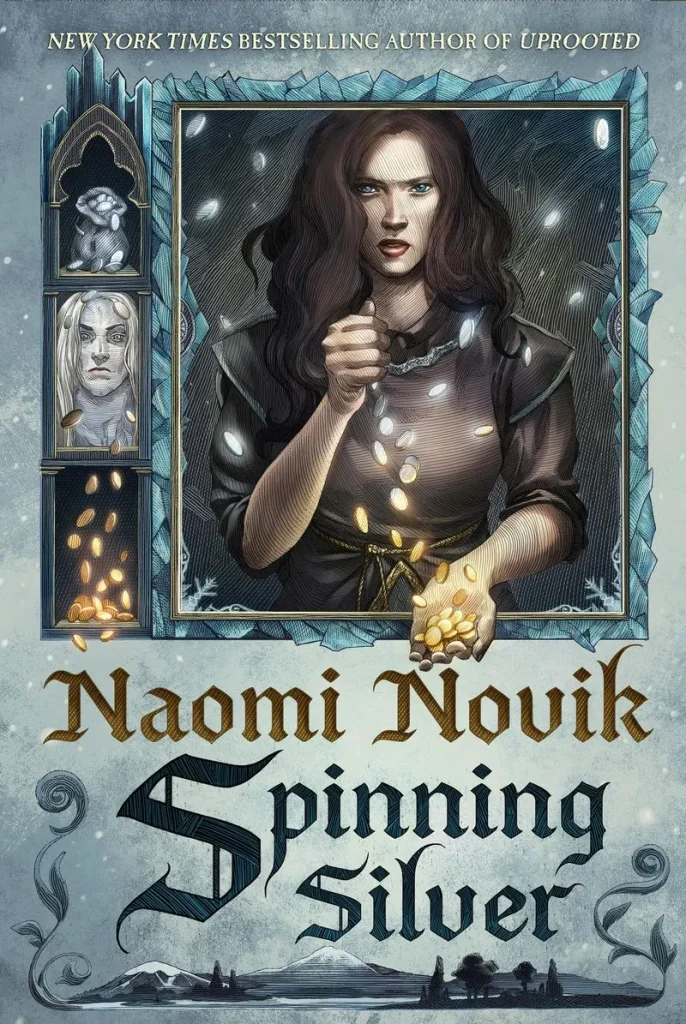Various story threads entwine, separate, and converge again, building the suspense through the entire novel.

Spinning Silver, by Naomi Novik is a unique retelling of Rumpelstiltskin. Rooted in Eastern European culture and folklore, the story starts with Miryem, a moneylender proud of her financial skill that rescued her family from poverty. Her boasting, however, catches the attention of the Staryk, magical beings who bring the winter and enact harsh penalties on trespassers. She is given an ultimatum: turn silver into gold and become the Staryk lord’s wife, or fail the task and be turned to ice. Her story intertwines with Wanda’s, the daughter of a drunk working for Miryem to pay off her father’s debt; and Irina’s, the daughter of a duke who is determined to marry her off to the tsar. The various stories’ threads entwine, separate, and converge again, building the suspense throughout the entire novel.
One of the best aspects of this book is the world-building. The story weaves seamlessly between the supernatural world, the world of the fey-like Staryk; and the human one, the kingdom of Lithvas. Interestingly, the story’s tension draws from all the various parts of the world Novik builds, coming in the form of magic, monsters, politics, and prejudice. The traditional fairytale of Rumpelstiltskin is recognizable, but the book crafts a much wider, complex world around it, as well as expanding the original plot and characters.
At its root, Spinning Silver is character-driven. The ambitions and mistakes of the characters are what create the conflict and plot of the book, and the characters’ decisions spiderweb out to affect the world and the lives of others in it. Even the magic in the world follows this, explaining that, in true Rumpelstiltskin fashion, the characters create magic by finding a way to follow through on impossible claims. Magic “came only when you made some larger version of yourself with words and promises, and then stepped inside and somehow grew to fill it.” This is true of Novik’s characters, who, despite having relatively little power in their worlds, all manage to use their skills to make an impact on their worlds past what seems possible.
Each of the characters has a unique background and struggle, which creates varying voices and goals that revolve around their own experiences and flesh out the world. Their views and concerns don’t always align with each other, creating suspenseful and interesting dynamics. Miryem grapples with the disapproval of her parents and the prejudice of those around her, Wanda deals with an abusive father and envy at seeing Miryem’s loving family, and Irina is thrust into a dangerous battle of wits for her life and for the kingdom that she has suddenly gained responsibility for. Having multiple viewpoints also allows for the unique and interesting experience of seeing characters from different perspectives and showcasing contrasting personalities and mindsets between the characters. However, the main downside of the book is that the sheer number of characters can become overwhelming. Point-of-view characters are introduced throughout the story, and some side characters gain points-of-view long after they are first introduced. It can be jarring to start a chapter in a new perspective so deep into the book.
Despite its flaws, Spinning Silver stands as a beautiful and unique fairytale retelling that, even with its basis in the familiar Rumpelstiltskin narrative, is still full of twists, mysteries, and unknowns. The landscape and prose are vivid, and for fans of original twists on fairy tales, Spinning Silver is definitely worth a read.
—Sariah Roulstone, Inscape Staff



